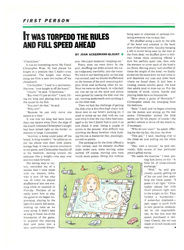
STAYING IN THE SWIM AT HOME
When it comes to distance training indoors, runners on treadmills and cyclists on stationary bikes no longer have a technological edge over their aquatic counterparts. The concept of swimming in place—explored by enterprising spa designers—has been refined by a company called SwimEx, Inc.
In the late 1970s several spa builders began lengthening the typical hot tub or spa and adding large hydrotherapy jets that produced streams of water and air strong enough to hold a swimmer in place. Twelve to 18 feet long, 7 to 8 feet wide and selling for as little as $6,500, "swim spas" are now manufactured by a dozen or so companies across the country. They cost far less than a full-sized indoor pool, but they also have their drawbacks. Most notable are the teeth-rattling turbulence and the disappointingly narrow stream of resistance that most of the jets produce. My experience with the typical swim spa is that you need unwavering concentration, tight goggles and half an hour of practice just to get the hang of it.
The SwimEx pool is different. Made of stainless steel and carrying a hefty $20,000 price tag, it is 12 feet long, 6½ feet wide and 4 feet deep, holds 3,200 gallons of water and operates on a simple principle. "The secret," says Stanley Charren, a Cambridge, Mass., entrepreneurial engineer who was one of the three founding partners, "is to move a lot of water at low pressure instead of a small amount at high pressure."
There are no jets to be found in the SwimEx, only five-foot-wide grates on either end below the waterline. An enclosed paddle wheel at the back draws water off the surface and propels it through a channel underneath the pool to the front, where it flows back out. In contrast to a swim spa's small area of churning water, nearly the entire surface of the SwimEx is in motion, like a gentle stream.
Swimming in place against the steady flow is as natural as doing laps in a pool, only better. Since you never reach the wall, you don't break your rhythm to turn every 25 yards, and you get a better workout in a shorter time. With the turn of a knob, the speed of the flow can easily be adjusted from less than 1 mph to close to 4 mph, a range good enough for all but the fastest competitors.
Charren, 62, has a chronically bad back, and his orthopedist suggested that he take up swimming. But he was soon discouraged because it was taking him two hours to swim for half an hour, with travel and locker-room time figured in. Charren tried a swim spa and was disappointed. He inquired about indoor lap pools and was told that it would cost him more than $100,000 to build one. He recalls, "My wife said, 'Let's use the money to buy a condo where there's a pool.' "
The Charrens bought the condo, but Stanley kept thinking about an aquatic treadmill. In 1984 he and Sy Mermelstein, a friend and fellow engineer, went to work and, after 1½ years of what Mermelstein calls "the classic garage operation" and several hundred thousand dollars, the first SwimEx was ready.
The pool is as well suited to beginners as it is to advanced swimmers, so it should prove valuable as both a teaching and coaching aid. Tillotson-Pearson Inc., a Warren, R.I.—based company that builds fiberglass boats, purchased SwimEx in December and began promoting it, but even before that, the small staff was fielding inquiries from health clubs, chiropractors and corporate fitness centers. But the majority of the potential SwimEx market may well be private consumers—those who want to swim year-round but, like Charren, consider the cost of enclosing a pool prohibitive. Some may not be ready to spend $20,000 on a personal-sized pool, but there will be a fiberglass model sometime this spring that will sell for roughly $14,000.
Now you can put a SwimEx next to your treadmill and stationary bicycle and train for your next triathlon without ever leaving the house.
Jim Harmon once held the Pine Bush (N.Y.) high school record in the 100-yard butterfly.
PHOTO
BILL SMITH PHOTOGRAPHY
The current in the SwimEx pool is pushed through grates by an interior paddle wheel.

